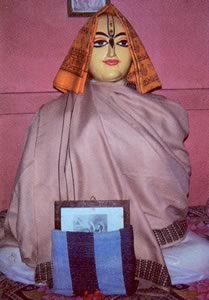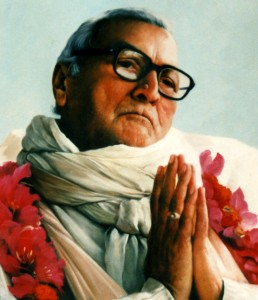
Chaitanya Mahaprabhu born Viśvambhara Miśra was a 15th-century Indian Hindu saint from Bengal who is considered to be the combined avatar of Radha and Krishna by Gaudiya Vaishnavas and various scriptures. The Bhavishya Purana (IV/10/29-33) and Manava Purana mention Chaitanya Mahaprabhu as an avatar of Lord Vishnu.

Nityānanda, also called Nitai, was a primary religious figure within the Gaudiya Vaishnava tradition of Bengal. Nitai was Chaitanya Mahaprabhu's friend and disciple. They are often mentioned together as Gaura-Nitai or Nimai-Nitai. Followers often refer to Nityānanda as "Sri Nityananda", "Prabhu Nityananda" or "Nityananda Rama".

Gaudiya Vaishnavism, also known as Chaitanya Vaishnavism, is a Vaishnava Hindu religious movement inspired by Chaitanya Mahaprabhu (1486–1534) in India. "Gaudiya" refers to the Gaura or Gauḍa region of Bengal, with Vaishnavism meaning "the worship of Vishnu". Specifically, it is part of Krishnaism—Krishna-centric Vaishnavite traditions.

Narottama Dasa Thakura, also known as Thakura Mahasaya, was a Gaudiya Vaishnava saint who spread Vaishnava bhakti throughout Odisha, in Bengal, and elsewhere in India. Narottama Dasa was the son of King Krishnananda Datta and Narayani Devi, who resided in Gopalpur Pargana of the modern-day Rajshahi district of Bangladesh. According to some, after the death of his father he entrusted his royal duties to the eldest son of his paternal uncle and left for Vrindavana.
The Chaitanya Charitamrita, composed by Krishnadasa Kaviraja in c. 1557, is written in Bengali with a great number of Sanskrit verses in its devotional, poetic construction, including Shikshashtakam. It is one of the primary biographies detailing the life and teachings of Caitanya Mahāprabhu, the founder of Gaudiya Vaishnavism. The stories of Chaitanya's life are mixed with philosophical conversations detailing the process of Bhakti yoga, with special attention given to congregational chanting of Krishna's names and the Hare Krishna mantra.

Rupa Goswami was a devotional teacher (guru), poet, and philosopher of the Gaudiya Vaishnava tradition. With his brother Sanatana Goswami, he is considered the most senior of the Six Goswamis of Vrindavan associated with Caitanya Mahaprabhu, a hidden avatar (incarnation) of Krishna in Kali Yuga.

Ekachakra is a small village, located 20 km away from the town of Rampurhat in the Birbhum District of West Bengal. Within Hindu tradition, the five Pandavas from the epic, Mahabharata are described as staying in Ekachakra during their years in exile. It is also famous as the birthplace of Nityananda Rama, a principal religious figure in the Gaudiya Vaishnava tradition.

Bhaktisvarupa Damodara Swami, also known as Dr. Thoudam Damodara Singh and by the honorific Sripada, was a Gaudiya Vaishnava spiritual leader, chemist, writer about religion and science, and poet. In 1971 he received spiritual initiation from A. C. Bhaktivedanta Swami Prabhupada. A few years later he became one of the religious leaders of the International Society for Krishna Consciousness.

Radha-Krishna is the combined form of the Hindu god Krishna with his chief consort and shakti Radha. They are regarded as the feminine as well as the masculine realities of God, in several Krishnaite traditions of Vaishnavism.

Isvara Puri was a monk who was a disciple of Madhavendra Puri from the Madhva Sampradaya. He met Chaitanya at Gaya, India, whereupon Mahaprabhu requested Puri to be his guru. The latter agreed and accepted Mahaprabhu as his disciple several days later, initiating him into the Gopal-mantra.
Raghunatha Bhatta Goswami (1505–1579) was a well known follower of the Vaishnava saint Chaitanya Mahaprabhu, and member of the influential Gaudiya Vaishnava group collectively known as the Six Goswamis of Vrindavan. He is regarded by followers in the Gaudiya tradition as an ideal practitioner of the Bhakti yoga system.

Gopala Bhatta Goswami (1503–1578) is one of the foremost disciples of the Vaishnava saint, Chaitanya Mahaprabhu, and a historical figure in the Gaudiya Vaishnava school of Hinduism. He was part of a group of Vaishnava devotees known collectively as the Six Goswamis of Vrindavan, who were influential in establishing the philosophical basis of the Gaudiya tradition in formalised writings.

Gadadhara Pandita, also known as Pandita Goswami, was a close childhood friend of Chaitanya Mahaprabhu. Gadadhara Pandita Goswami is described as a handsome young boy, student of Nyaya and ranked highest among the inner circle of Chaitanya Mahaprabhu's followers.

Radha Ramana is one of the combined forms of the Hindu deities Radha and Krishna, besides their BankeBihari and Radha-Vallabha forms.

Haridasa Thakur was a Vaishnava saint known for playing a part in the initial propagation of the Hare Krishna movement. He is considered to be a known convert of Chaitanya Mahaprabhu, apart from Rupa Goswami and Sanatana Goswami. His story of integrity and faith in the face of adversity is told in Chaitanya Charitamrita, Antya lila. It is believed that Chaitanya Mahaprabhu himself designated Haridasa as nāmācarya, meaning the 'teacher of the Name'. Haridasa Thakura was a devotee of the deity Krishna, and is regarded to have practised the chant of his veneration, Hare Krishna, 300,000 times daily.
Śrinivāsa Ācārya Ṭhākura was a famous Vaishnava guru, the pupil of Jiva Gosvamin and teacher of Yadunandana dasa and Radhavallabha dasa, among others. He converted King Bir Hambir to Vaishnava. His daughter, Hemalata Thakurani, was also a guru.

Bijoy Krishna Goswami, also known by the honorific Gosaiji, was a Hindu social reformer and religious figure in India during the British period.

Sri Radha Raman Temple, is a Hindu temple situated in Vrindavan, India. It is dedicated to Krishna who is worshiped as Radha Ramana. This temple is counted as one of the Seven most revered ancient temples of Vrindavan along with Radha Vallabh Temple, Radha Damodar Temple, Radha Madanmohan Temple, Radha Govindji Temple, Radha Shyamsundar Temple and Radha Gokulnandan Temple. The temple houses the original Shaligram deity of Krishna alongside goddess Radha.

Prataparudra Deva was the third Gajapati emperor of Odisha from the Suryavamsa Gajapati Empire founded by his grandfather Kapilendra Deva Routaraya. He reigned from 1497 to 1540 CE. Besides being a monarch, he was a devout Vaishnava and adherent of the famous saint, Sri Chaitanaya who arrived in Odisha during his reign. His life was extremely occupied with overwhelming military campaigns in defense of his inherited territory from three frontal invasions by the enemy states Vijayanagar, Hussain Shahi dynasty of Bengal and Turko-Persian Qutb Shahi dynasty of Golconda. He lost large portions of his territory to the neighboring enemy states initiating the dissolution of Odisha's military hegemony and imperial status that continued for nearly a period of 600 years before him.

Bhakti Rakshak Sridhar was an Indian guru, writer, sannyasi and spiritual leader in the Gaudiya Vaishnava tradition of Chaitanya Mahaprabhu, founder-president-acharya of the Sri Chaitanya Saraswat Math.















